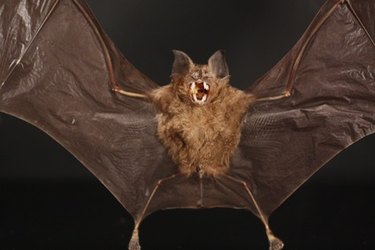
On average, the highest pitch that the human ear can hear is about 20 kilohertz, which is 20 thousand cycles per second. If the frequency of a sound is greater than 20 kilohertz, it is called ultrasonic sound or ultrasound. A number of animals are capable of emitting ultrasonic frequencies and use it for several purposes.
Oil Bird
Video of the Day
Steatornis caripensis, the oil bird of South America, forages during the night and sleeps in caves during the day. To fly about without injury in the shadowy world in which it lives, the oil bird employs echolocation. The sounds that it produces for this purpose include frequencies in the ultrasonic range. But most of its echolocation frequencies are lower than 20 kilohertz. So ultrasonic frequencies may not be too important in the oil bird's life, according to the International Journal of Avian Science.
Video of the Day
Bats
In the 18th century, clever experiments by Lazzaro Spallanzani demonstrated that bats did not use their eyes to find their way around in darkness, but something else. Much later, Griffin and Galambos began to unravel the secrets of the ultrasonic emissions and the echolocation that bats use to fly in the dark, according to the British Society of Rheumatology. Besides avoiding obstacles, bats use ultrasound to find and catch insects. Not all bats have the same dexterity in echolocation. Some species are better at it than others.
Dolphins and Whales
Dolphins and toothed whales use echolocation to navigate and locate prey. This echolocation takes the form of a rapid series of clicks, often emitted at ultrasonic frequencies. Toothed whales and dolphins have no vocal chords, but produce the sound by structures in the nasal passage called "phonic lips" according to the Journal of Experimental Biology. Another class of whales produce song, usually in ranges audible to the human ear, but often slipping into frequencies higher than 20 kilohertz, according to the Department of Physics and Astronomy of Georgia State University.
Moths
Some night-flying moths of the family Noctuidae produce ultrasonic sounds while flying. Contact between the edges of their hind wings produces the sounds, according to D.A. Waters and D. Jones of the School of Biological Sciences, Bristol. The moths also can hear the bats' ultrasound. This helps them escape predation. Other moths of the family Arctiidae use ultrasound in courtship. They produce the sound by means of structures called tymbal organs, according to the Journal of Insect Behavior.
Mice
When male mice perceive the pheromones of a female counterpart, they respond with ultrasonic sounds. These seem to be courtship songs, according to Timothy E Holy and Zhongsheng Guo.
Frogs
Amolops tormotus, a frog endemic to China, produces ultrasonic sounds. It uses ultrasound to communicate with other frogs, according to Archives. Huia cavitympanum, a frog that resides in Borneo, has the same ability, according to the Publication of Peer-Reviewed Science.
Grasshopper
Some grasshoppers use ultrasonic frequencies in their mating calls, according to the College of Agriculture and Life Sciences of North Carolina State University.